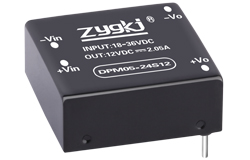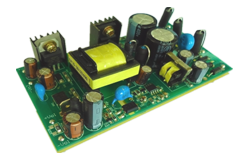الإخبارية
DC Power Conversion: Understanding the Basics and Best Practices
المؤلف : ZYG Power Module Time: 2023-6-4
Power conversion is an essential process in modern electronics, enabling devices to operate using different voltage and current levels. In this article, we will take a closer look at DC power conversion, its basics, and best practices.
DC power conversion refers to the process of converting DC voltage levels from one level to another. This process is necessary because different electronic devices operate using different voltage levels. For example, a smartphone may operate using a voltage of 3.7 volts, while a laptop may require a voltage of 19 volts. To ensure that electronic devices can operate efficiently and safely, DC power conversion is used to convert the voltage levels to suit the specific needs of each device.
The process of DC power conversion involves the use of power electronic devices such as diodes, transistors, and capacitors. These devices are used to regulate the voltage and current levels of the DC power, ensuring that the output voltage is the same as the input voltage, or that it is a specific value that is required by the device.
There are two main types of DC power conversion: linear and switching. Linear power conversion is a simple process that involves the use of a voltage regulator to maintain a constant voltage output. This process is highly efficient when the input voltage is close to the desired output voltage. However, when there is a significant difference between the input and output voltage, linear power conversion can result in high power losses, making it an inefficient method.
Switching power conversion, on the other hand, is a more complex process that involves the use of a switching regulator. This method is highly efficient, even when the input voltage is significantly different from the desired output voltage. The switching regulator works by switching the DC input voltage on and off at a high frequency, resulting in a stable output voltage. The switching regulator is highly efficient because it reduces the power loss associated with linear power conversion.
Best Practices for DC Power Conversion
When designing and implementing DC power conversion systems, there are several best practices that engineers should follow to ensure that the system is efficient, reliable, and safe. These best practices include:
1. Use High-Quality Components
The quality of the components used in the power conversion system can significantly impact the performance and reliability of the system. It is essential to use high-quality components that are designed to operate at the required voltage and current levels. Using low-quality components can result in system failure, safety hazards, and reduced efficiency.
2. Use Proper Cooling Techniques
Power conversion systems generate a significant amount of heat, which can impact the performance and reliability of the system. It is essential to use proper cooling techniques, such as heat sinks, fans, or liquid cooling, to ensure that the system operates at a safe temperature.

3. Follow Safety Standards
DC power conversion systems can pose a safety hazard if not designed and implemented correctly. It is essential to follow safety standards and guidelines, such as those set by the International Electrotechnical Commission (IEC), to ensure that the system is safe for use.
4. Test and Monitor the System
To ensure that the DC power conversion system is operating efficiently and reliably, it is essential to test and monitor the system regularly. This includes testing the system under different load conditions, monitoring the temperature of the components, and checking for any abnormal behavior.
خاتمة
DC power conversion is an essential process in modern electronics, enabling devices to operate using different voltage and current levels. Understanding the basics of DC power conversion and following best practices can help engineers design and implement efficient, reliable, and safe power conversion systems. By using high-quality components, proper cooling techniques, following safety standards, and testing and monitoring the system regularly, engineers can ensure that the DC power conversion system operates at peak performance.
سابق: XXYY Series DC DC Converter
التالي: Shop AC to DC Converters: Convert AC Power to DC with Ease!
معلومات ذات صلة
-
2023-9-11
Versatile Adjustable Power Supply Module: The Key to Optimal Voltage Control
Having a reliable and efficient power supply is crucial for the smooth operation of various devices and systems. Whether it is in the field of electronics, telecommunications, or even renewable energy, the ability to control and adjust voltage levels is essential. That is where a versatile adjustable power supply module comes into play. This module acts as a key component in achieving optimal voltage control, allowing for flexibility and adaptability in various applications. One of the primary advantages of a versatile adjustable power supply module is its ability to provide a wide range of voltage outputs. This flexibility is achieved through the use of adjustable voltage regulators, which can be easily adjusted to the desired voltage levels. This feature is...
عرض التفاصيل -
2023-8-10
China ZP Series: High-Efficiency AC DC Converter
In today's rapidly evolving technological landscape, efficient power management has become an indispensable part of numerous industries. As the demand for energy-efficient solutions continues to rise, the ZP Series: High-Efficiency AC DC Converter has emerged as a game-changer in the field of power conversion technology. This article aims to explore the key features and benefits of the ZP Series, shedding light on its significant impact across various sectors. The ZP Series AC DC Converter stands out due to its exceptional energy efficiency, reliability, and versatility. Designed and manufactured by leading experts in the field, this cutting-edge converter promises to revolutionize power supply systems across industries. Whether it be in telecommunications, industrial automation, or renewable energy, the ZP Series offers a...
عرض التفاصيل -
2023-5-24
Efficient 120V AC to 12V DC Converter for Your Electrical Needs
If you're in need of a reliable and efficient power source for your electrical devices, a 120V AC to 12V DC converter is an essential tool. Whether you're working on a DIY project at home, need power for your vehicle, or need a portable power source for camping or outdoor activities, a 120V AC to 12V DC converter can provide you with the power you need. At its most basic level, a 120V AC to 12V DC converter is a device that converts alternating current (AC) from a wall outlet into direct current (DC) that can be used to power electronic devices. The converter typically consists of a transformer, rectifier, and filter circuit, and is designed to be highly efficient...
عرض التفاصيل -
2023-6-19
Design and Analysis of a Bidirectional DC-DC Converter for Energy Storage Systems
Energy storage systems (ESS) have been gaining popularity in recent years due to the increased need for renewable energy integration and grid stabilization. One of the key components of an ESS is the bidirectional DC-DC converter, which is responsible for converting the DC voltage of the battery to the appropriate voltage level for the load or grid, and vice versa. In this article, we will discuss the design and analysis of a bidirectional DC-DC converter for energy storage systems. Design Considerations: The design of a bidirectional DC-DC converter for ESS involves several considerations. Some of the key design parameters are: 1. Power rating: The power rating of the converter should be chosen to match the power requirements of the load...
عرض التفاصيل -
2023-4-18
محول AC-DC: تحويل التيار المتردد إلى تيار مباشر
An AC-DC converter is an electronic device that converts the alternating current (AC) supply voltage to direct current (DC) voltage. This type of converter is used in many applications such as power supplies, battery chargers, and lighting systems. In this article, we will discuss the working principle of an AC-DC converter and its different types. Working Principle The working principle of an AC-DC converter is based on rectification. Rectification is the process of converting an AC voltage into a DC voltage. This process involves the use of diodes to rectify the AC voltage. A diode is an electronic component that allows current to flow in one direction only. The AC voltage is first stepped down to a lower voltage using...
عرض التفاصيل -
2023-5-29
HP Series AC DC Converter: Efficient Power Conversion for High-Performance Applications
When it comes to high-performance applications, there\'s no room for error. Every component must be perfectly designed and optimized for maximum efficiency and reliability. This is especially true for power converters, which are responsible for delivering the right amount of power to critical systems. That\'s where the HP Series AC DC converter comes in. This powerful and efficient converter is designed to meet the needs of even the most demanding applications. The HP Series AC DC converter is a high-performance power converter that delivers reliable and efficient power to critical systems. It is designed to operate in harsh environments, making it ideal for use in a wide range of applications, including aerospace, defense, and industrial applications. With its high efficiency...
عرض التفاصيل


















